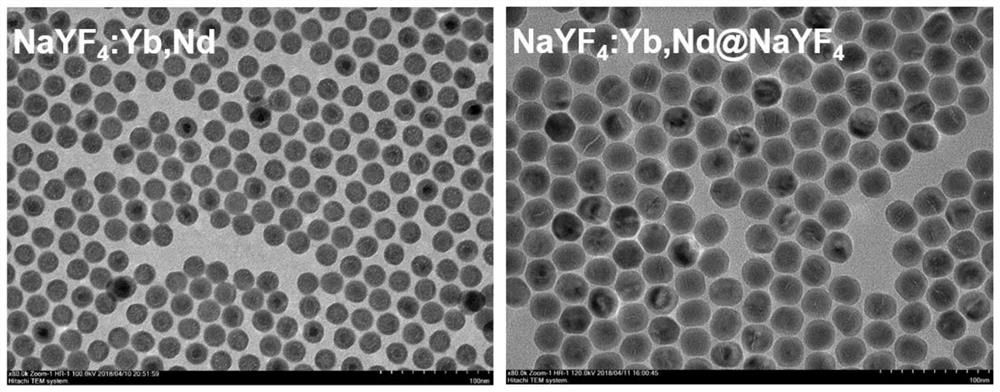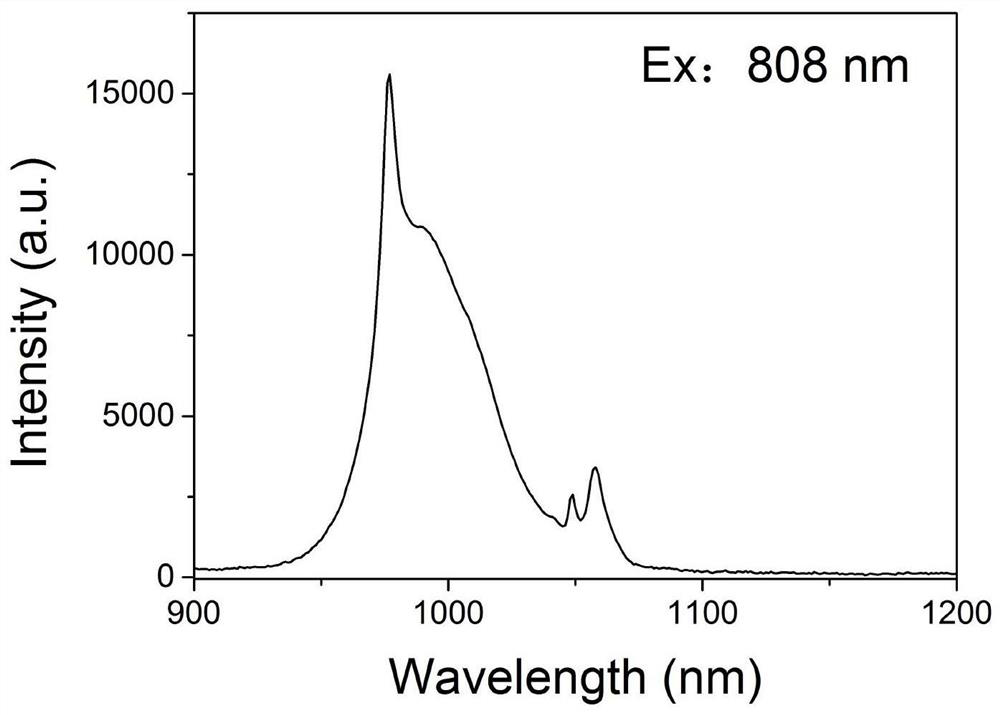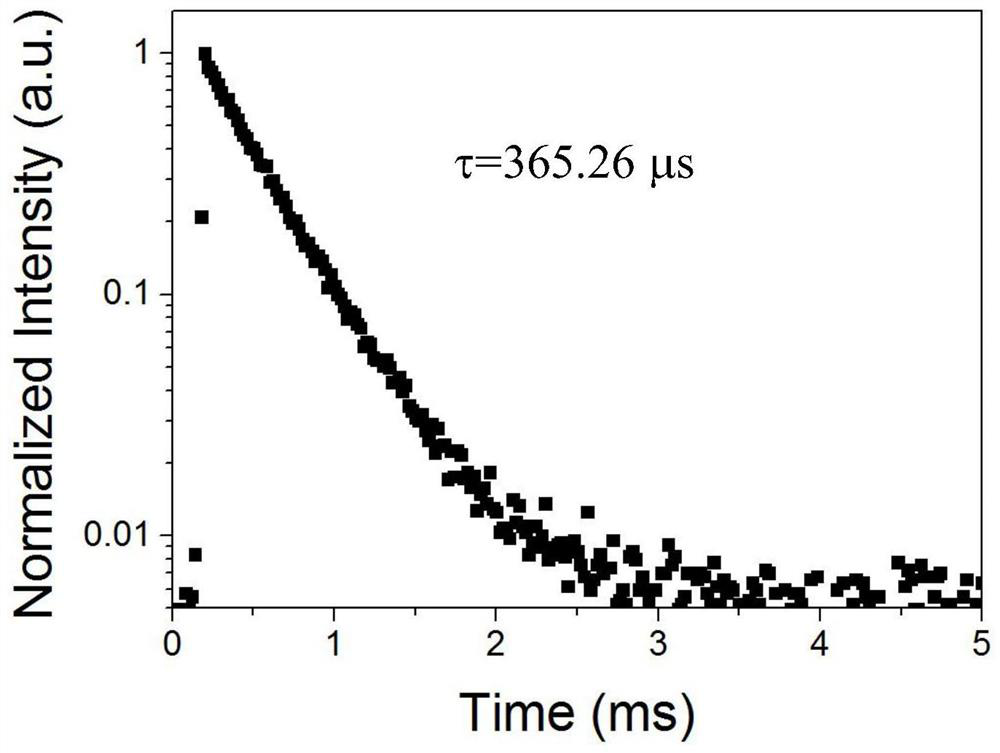An immunochromatographic detection method based on near-infrared luminescent rare earth nanomaterials
A rare earth nanomaterial, immunochromatographic detection technology, applied in material inspection products, analytical materials, measuring devices, etc., can solve the problems of limited luminescence brightness of materials, low luminescence quantum efficiency, influence of immunochromatography sensitivity, etc., to achieve repeatability Strong, strong fluorescence emission, good stability
- Summary
- Abstract
- Description
- Claims
- Application Information
AI Technical Summary
Problems solved by technology
Method used
Image
Examples
Embodiment 1
[0069] Example 1: NaYF 4 :Yb,Nd@NaYF 4 Preparation and Luminescent Properties of Near Infrared Rare Earth Nanomaterials
[0070] (1) Synthesis of NaYF by solvothermal method 4 :Yb,Nd@NaYF 4
[0071] Prepare inner core NaYF 4 :Yb,Nd:
[0072] Weigh 1 mmol of rare earth acetate Ln(CH 3 COO) 3 (wherein yttrium acetate Y(CH 3 COO) 3 Accounting for 33%, ytterbium acetate Yb (CH 3 COO) 3 Accounting for 7%, Nd(CH 3 COO) 3 Accounting for 60%) into a 100mL three-necked flask, add 6mL oleic acid and 15mL 1-octadecene; heat up to 120°C under a nitrogen atmosphere, and stir until the solid is completely dissolved.
[0073] Heating was then stopped, the solution was cooled to room temperature, and a solution containing 2.5 mmol NaOH and 4 mmol NH was added 4 The methanol solution of F was 10 mL; under nitrogen purging, the solution was heated to 120°C to remove the methanol in the solution; finally, the solution was heated to 300°C and maintained for 1 h.
[0074] After the ...
Embodiment 2
[0083] Example 2: LiYF 4 : Preparation and Luminescent Properties of Nd Near Infrared Rare Earth Luminescent Nanomaterials
[0084] (1)LiYF 4 : Synthesis of Nd
[0085] Weigh 0.95mmolYCl 3 , 0.05molNdCl 3 , 6 mL of oleic acid, and 15 mL of 1-octadecene were put into a 100 mL three-necked flask; vacuum was applied to remove oxygen and water in the system, and the temperature was raised to 130°C until the solid was completely dissolved and the solution was clear and transparent.
[0086] Then the solution was cooled to room temperature, and the solution containing 0.106g LiOH and 0.148gNH was added dropwise 4 F methanol solution 8mL. Nitrogen was blown, and the solution was heated to 120°C to remove methanol. After 30 minutes, the reaction system was sealed, and the temperature was rapidly raised to 300°C, and maintained for 90 minutes. After the reaction is completed, the system is cooled to room temperature, and the precipitate obtained by centrifuging the solution is Li...
Embodiment 3
[0091] Example 3: NaYbF 4 :Er,Ce@NaYF 4 :Yb@NaYbF 4 :Nd@CaF 2 Preparation and luminescent properties of near-infrared luminescent nanomaterials
[0092] (1)NaYbF 4 :Er,Ce@NaYF 4 :Yb@NaYbF 4 :Nd@CaF 2 Synthesis
[0093] Weigh 1mmol rare earth trifluoroacetate Ln(CF 3 COO) 3 (where Yb(CF 3 COO) 3 Accounting for 93%, Er(CF 3 COO) 3 Accounted for 2%, Ce(CF 3 COO) 3 Accounting for 5%) into a 100mL three-neck flask, add 10mmol oleic acid, 10mmol oleylamine and 20mmol 1-octadecene; raise the temperature to 120°C under a nitrogen atmosphere, and stir until the solid is completely dissolved. Heating was then stopped, the solution was cooled to room temperature, and a solution containing 2.5 mmol NaOH and 4 mmol NH was added 4 The methanol solution of F was 10 mL; under nitrogen purging, the temperature of the solution was raised to 120°C to remove the methanol in the solution; finally, the temperature of the solution was raised to 300°C and maintained for 30 minutes. A...
PUM
| Property | Measurement | Unit |
|---|---|---|
| size | aaaaa | aaaaa |
| size | aaaaa | aaaaa |
| particle diameter | aaaaa | aaaaa |
Abstract
Description
Claims
Application Information
 Login to View More
Login to View More - R&D
- Intellectual Property
- Life Sciences
- Materials
- Tech Scout
- Unparalleled Data Quality
- Higher Quality Content
- 60% Fewer Hallucinations
Browse by: Latest US Patents, China's latest patents, Technical Efficacy Thesaurus, Application Domain, Technology Topic, Popular Technical Reports.
© 2025 PatSnap. All rights reserved.Legal|Privacy policy|Modern Slavery Act Transparency Statement|Sitemap|About US| Contact US: help@patsnap.com



